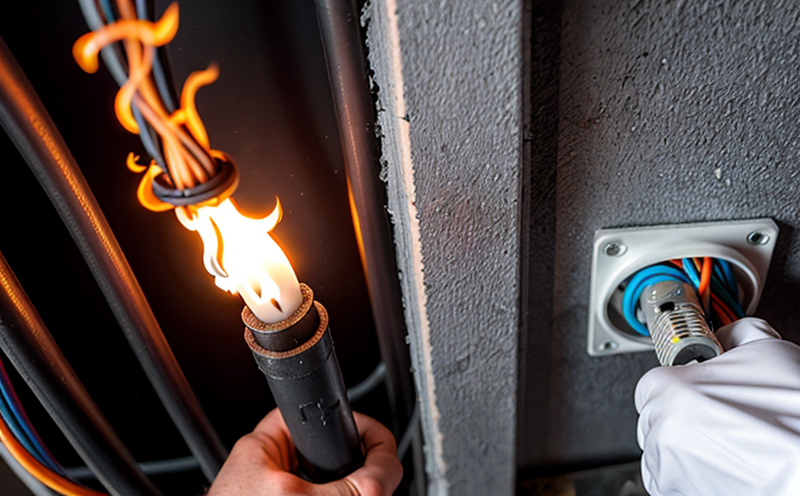BS EN 60332-3-24 Flame Test of Bunched Cables
The BS EN 60332-3-24 standard is a critical component in the fire safety testing regime for electrical and electronic equipment. Specifically, it addresses the flame propagation behavior of bunched cables when subjected to an ignition source under controlled conditions. This test ensures that even if a cable catches fire, it will not spread uncontrollably along its length, thus preventing potential hazards such as fires or short circuits in critical facilities.
The importance of this standard cannot be overstated, especially for industries like aviation, healthcare, and data centers, where the risk of electrical fires is high due to the presence of large quantities of cabling. The test evaluates not only the resistance of cables but also their ability to maintain structural integrity during a fire scenario, thereby contributing significantly to overall system safety.
The BS EN 60332-3-24 standard specifies three different tests: A1, A2, and A3, each targeting different aspects of cable flame behavior. For the A2 test, which is specifically relevant here, bunched cables are exposed to a small flame for a specified duration. The goal is to determine whether the flame can spread along the length of the cable or if it extinguishes at a certain point.
The testing process involves precise specimen preparation and rigorous execution. Specimens must be cut into specific lengths as per standard requirements, with care taken to ensure uniformity across all samples. Once prepared, they undergo the A2 test where an ignition source is applied for 10 seconds. The duration of this exposure is critical; any deviation might lead to incorrect results.
After the test, detailed observations are made regarding the behavior of the flame along the cable's length. This includes noting the rate at which the flame propagates and whether it extinguishes within a prescribed distance or continues spreading. The data collected during these tests is then analyzed to ensure compliance with the specified criteria.
The BS EN 60332-3-24 standard also emphasizes the importance of post-test inspections, where any charred remains or melted parts are examined for further insights into the cable's performance under fire conditions. These observations help in refining future designs and improving product safety standards.
Understanding the broader context helps in appreciating the significance of this test within the wider framework of fire safety measures. By ensuring that cables meet stringent testing requirements, we contribute to safer environments by minimizing the risk of fires caused by electrical faults or accidental ignition sources.
Scope and Methodology
| Test Parameter | Description |
|---|---|
| Ignition Source | A small flame is applied for 10 seconds. |
| Specimen Preparation | Cables are cut into specific lengths, ensuring uniformity across all samples. |
| Observation Metrics | The rate and distance of flame propagation along the cable's length. |
| Test Procedure | Details |
|---|---|
| Specimen Preparation | Cables are cut to a specified length, ensuring no sharp edges or protrusions. |
| Ignition | A small flame is applied for 10 seconds. The duration and intensity of the flame are critical. |
| Observation | The behavior of the flame along the cable's length is closely monitored. |
| Post-Test Inspection | Any charred remains or melted parts are examined for further insights into the cable's performance under fire conditions. |
International Acceptance and Recognition
The BS EN 60332-3-24 standard is widely recognized across Europe and many other parts of the world for its stringent approach to ensuring fire safety in electrical installations. Compliance with this standard demonstrates a commitment to quality and safety, which is crucial for manufacturers aiming to meet regulatory requirements globally.
Many international standards bodies, including ISO and IEC, have adopted or referenced similar methodologies, further emphasizing its importance in the global context. The recognition extends beyond mere compliance; it represents a benchmark for excellence in fire safety testing, making products more trustworthy and reliable in competitive markets.
For manufacturers and suppliers operating in regulated industries such as aviation, healthcare, and data centers, adherence to this standard is not just mandatory but also enhances their reputation and market position. It assures customers that the products meet rigorous international standards, thereby fostering trust and confidence.
Competitive Advantage and Market Impact
- Enhanced safety: Compliance with BS EN 60332-3-24 ensures that cables perform reliably under fire conditions, reducing the risk of fires in critical facilities.
- Better reputation: Meeting these stringent standards enhances a company's reputation as a leader in quality and safety, which is highly valued by customers and stakeholders.
- Increased market access: Products that meet this standard are more likely to be approved for use in various regulated markets, opening up new opportunities for growth.
- Competitive edge: Superior fire resistance can set products apart from competitors, making them preferred choices for safety-conscious buyers.
The acceptance and recognition of BS EN 60332-3-24 contribute significantly to a company's competitive advantage. By ensuring compliance, manufacturers demonstrate their commitment to safety and quality, which is increasingly becoming a deciding factor in market selection.





